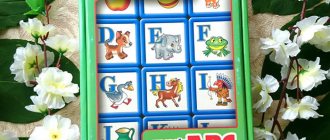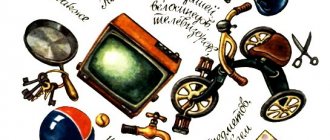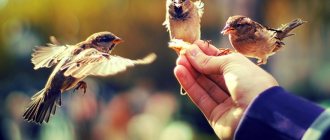We develop speech, voice, memory using proven logorhythmic methods.
Contained in sections:
- The work of a speech therapist. Speech therapy 8526
By groups:
- Senior group
- Preparatory group
- Middle group
- Junior group
Showing publications 1-10 of 1493. All sections | Logorhythmics. Logorhythmic exercises
New
Photo
The best
Summary of educational activities on speech development with elements of logorhythmics in the senior group “Transport” Goal: Children must learn the names of types of transport (car, bus, tram, plane, rocket, missile, motorcycle, elementary parts of cars (cabin, steering wheel, pedal, body, wheels. Objectives: correctional and educational: 1. Expanding ideas about types of transport. 2. consolidate and…
Scenario of musical entertainment with logori elements for children 4–6 years old
"ONCE UPON A TIME IN A WINTER FOREST"
Goal: To consolidate children’s understanding of the characteristic signs of winter, the life of wild animals and wintering birds through musical and play activities. Improving the ability to coordinate speech with movement. Development of speech and motor activity, creative…
How to write a term paper on speech therapy
07.09.2010 253386
These guidelines are compiled to help students gain an understanding of the content and structure of coursework in speech therapy.
Logopedia of pedagogical science that studies anomalies of speech development with normal hearing, explores the manifestations, nature and mechanisms of speech disorders, develops the scientific basis for overcoming and preventing them means of special training and education.
The subject of speech therapy as a science is speech disorders and the process of training and education of persons with speech disorders.
The object of study is a person suffering from a speech disorder.
The main task of speech therapy as a science is the study, prevention and elimination of various types of speech disorders.
Coursework in speech therapy is a student's scientific and experimental research. This type of educational activity, provided for by the educational and professional program and curriculum, contributes to the acquisition of skills in working with literature, analyzing and summarizing literary sources in order to determine the range of insufficiently studied problems, determining the content and methods of experimental research, processing skills and qualitative analysis of the results obtained. The need to complete coursework in speech therapy is due to the updating of knowledge concerning the content, organization, principles, methods and techniques of speech therapy work.
As a rule, during their studies, students must write two term papers - theoretical and practical.
The first course work should be devoted to the analysis and synthesis of general and specialized literature on the chosen topic. Based on this analysis, it is necessary to justify and develop a method of ascertaining (diagnostic) experiment.
In the second course work, it is necessary to provide an analysis of the results obtained during the ascertaining experiment, as well as determine the directions and content of speech therapy work, and select adequate methods and techniques of correction.
So, let’s present the general requirements for the content and design of coursework in speech therapy.
The initial and most important stage of working on a course project is the choice of a topic, which is either proposed by the supervisor or chosen by the student independently from a list of topics that are consistent with the areas of scientific research of the department.
Each topic can be modified, considered in different aspects, but taking into account a theoretical and practical approach. Having chosen a topic, the student needs to think through in detail its specific content, areas of work, practical material, etc., which should be reflected both in the formulation of the topic and in the further construction of the study. It should be recalled that the chosen topic may not only have a purely theoretical orientation, for example: “Dysarthria. Characteristics of the defect”, “Classification of dysgraphia”, but also take into account the practical significance of the problem under consideration, for example: “Speech therapy work on speech correction for dysarthria”. It should also be taken into account that when formulating a topic, excessive detail should be avoided, for example: “Formation of prosodic components of speech in preschoolers of the sixth year of life attending a preschool institution for children with severe speech impairments.”
The course work includes such mandatory parts as: introduction, three chapters, conclusion, bibliography and appendix.
The text of the term paper begins with the title page . An example of its design can be seen here.
Then the content of the work is given, in which the names of chapters, paragraphs, and sections are formulated in strict accordance with the content of the thesis. An example of its design can be seen here.
In the text, each subsequent chapter and paragraph begins on a new page. At the end of each chapter, the materials are summarized and conclusions are formulated.
The introduction reveals the relevance of the problem under consideration in general and the topic being studied in particular; the problem, subject, object, and purpose of the study are defined. In accordance with the goal and hypothesis, objectives and a set of research methods aimed at achieving the objectives must be defined.
The relevance of the topic lies in reflecting the current level of pedagogical science and practice, meeting the requirements of novelty and usefulness.
When defining the research problem, it is important to indicate what practical tasks it will help to implement in training and educating people with speech pathology.
The object of research is understood as certain aspects of pedagogical reality, perceived through a system of theoretical and practical knowledge. The ultimate goal of any research is to improve this object.
The subject of research is some part, property, element of an object, i.e. the subject of research always indicates a specific aspect of the object that is to be studied and about which the researcher wants to gain new knowledge. An object is a part of an object.
You can give an example of the formulation of the object, subject and problem of research:
– The object of the study is the speech activity of preschool children with phonetic-phonemic speech disorders.
– The subject of the study is the features of intonation speech of children with phonetic-phonemic speech disorders.
– The research problem is to determine effective directions for speech therapy work on the formation of intonation expressiveness of speech in the system of correctional intervention.
The purpose of the study contributes to the specification of the object being studied. The goal of any research is to solve a specific problem. The goal is specified in tasks taking into account the subject of research.
The research objectives are formulated in a certain sequence, which determines the logic of the research. The research objectives are set on the basis of a theoretical analysis of the problem and an assessment of the state of its solution in practice.
The first chapter is an analysis of literary sources, which examines the state of this problem in historical and modern aspects, and presents the most important theoretical principles that formed the basis of the study.
When writing the first chapter, you should pay attention to the fact that the text of the course work must be written in a scientific style. When presenting scientific material, it is necessary to comply with the following requirements:
– Specificity – a review of only those sources that are necessary to disclose only a given topic or solve only a given problem;
– Clarity – which is characterized by semantic coherence and integrity of individual parts of the text;
– Logicality – which provides for a certain structure of presentation of the material;
– Reasoning – evidence of thoughts (why this and not otherwise);
– Precision of wording, excluding ambiguous interpretation of the authors’ statements.
A literary review of the state of the problem being studied should not be reduced to a consistent presentation of literary sources. It should present a generalized description of the literature: highlight the main directions (currents, concepts, points of view), analyze in detail and evaluate the most fundamental works of representatives of these directions.
When writing a work, the student must correctly use literary materials, make references to the authors and sources from which the results of scientific research are borrowed. Failure to provide required references will reduce your coursework grade.
As a rule, in coursework on speech therapy, references to literary sources are formatted as follows: the number of the cited source in the general list of references is placed in square brackets. For example: General speech underdevelopment is a speech pathology in which there is a persistent lag in the formation of all components of the language system: phonetics, vocabulary and grammar [17].
When using quotations, in square brackets, in addition to indicating the source number, the page number from which this excerpt is taken is indicated, for example: Speech rhythm is based on a physiological and intellectual basis, since, firstly, it is directly related to the rhythm of breathing. Secondly, being an element that performs a communicative function, “correlates with meaning, i.e. controlled intellectually” [23, P.40].
However, course work should not be of a purely abstract nature, so you should not abuse the unreasonable abundance of citations. Quoting should be logically justified, convincing and used only when really necessary.
In the second chapter , devoted to experimental research, the organization should be described and the program of the ascertaining experiment should be presented. The survey methodology, as a rule, consists of a description of several series of tasks, with detailed instructions, visual and lexical material, the procedure for completing tasks by experiment participants, and scoring criteria. This chapter also provides a qualitative and quantitative analysis of the results obtained.
When analyzing the results of an experiment, it is necessary to use a scoring system. Examples of various criteria for quantitative and qualitative assessment are presented in the following works:
– Glukhov V.P. Formation of coherent speech in preschool children with general speech underdevelopment. - M.: Arkti, 2002. - 144 p.
– Fotekova T.A. Test methodology for diagnosing oral speech of primary schoolchildren. - M.: Arkti, 2000. - 56 p.
– Levchenko I.Yu. Pathopsychology: Theory and practice. - M.: Academy, 2000. - 232 p.
In order to visually present the results obtained during the experimental study, it is recommended to use tables, graphs, diagrams, etc. Histograms can be used in a variety of ways - columnar, cylindrical, planar, volumetric, etc. An example of the design of tables, figures, and histograms can be found here.
The third chapter provides a rationale for the proposed methods and techniques and reveals the content of the main stages of correctional work.
The conclusion contains a summary of the material presented and the main conclusions formulated by the author.
The bibliography must contain at least 25 sources. The list includes bibliographic information about the sources used in preparing the work. An example of its design can be seen here.
In the application you can present bulky tables or illustrations, examination protocols, observation records, products of activity (drawings, written works of children), notes from speech therapy classes, etc.
The volume of one course work must be at least 30 pages of typewritten text.
In general, coursework in speech therapy is the basis for a future thesis, in which the study of the begun problem can be continued, but from the standpoint of a different approach or a comparative analysis of the disorders being studied in different age categories of people with different types of speech disorders.
The content and format of theses in speech therapy can be found here.
Literature:
1. How to write a term paper on speech therapy: Methodological recommendations. Educational and methodological manual / Comp. Artemova E.E., Tishina L.A. / Ed. Orlova O.S. – M.: MGOPU, 2008. – 35 p.
2. Research work of students in the system of higher professional pedagogical education (specialty 031800 - Speech therapy). Methodological recommendations for completing the thesis / Compiled by. L.V. Lopatina, V.I. Lipakova, G.G. Golubeva. - St. Petersburg: Publishing house of the Russian State Pedagogical University named after. A. I. Herzen, 2002. - 140 p.
Open lesson on logorhythmics in the senior group
Scenario for an open lesson on Logori.
Description of the material: Every year our holding hosts Open Days, the purpose of which is to introduce parents to specialists and teachers of additional education, as well as to the methods used in working with children. We present various areas (artistic and aesthetic, creative, physical education, educational) in the form of master classes and open classes. My circle on musical logorhythmics belongs to the artistic and aesthetic cycle and, thinking through the course of the lesson, I decided to devote it to a conversation about rhythm and ways to develop a sense of rhythm in children. Author: Olga Vasilievna Podkolzina, music director of the State Budgetary Educational Institution “School No. 1056” in Moscow. Goal: To interest parents and children in the subject of logorhythmics. Objectives: introduce rhythm games; show ways to develop a sense of rhythm in a child; create a relaxed gaming atmosphere.
Progress of the event
Guests (parents with children) enter the hall to the music. Musical director: Hello, my friends, I am glad to see you all. Our garden is open to guests, parents and their children. I suggest you stand in a circle and start our fun lesson! (Everyone stands in a circle.)
And before we start, we need to greet each other.
Communication game “Hello, friend!” M.Yu. Kartushina 1. The legs walked (Children and parents move scattered around the hall.)
Straight along the path, They met a friend
(Towards the end of the verse they stand in pairs.)
Little legs.
Chorus: Hello, hello, (Holding hands, couples perform a “spring”)
Hello, dear friend, Hello, hello,
(Do a “spring”).
Look around!
(Spread their arms to the sides).
Hello, hello,
(They make a “spring”).
Smile at me!
(Pretend to smile by raising your hands to your chin.)
Hello, hello,
(They make a “spring”).
Bow your head!
(Bow to each other).
2. The legs ran
(They run on their toes scattered around the hall).
Right along the path, Met a friend
(Get into pairs).
Little feet.
Chorus. (Movements are repeated).
3. The legs jumped
(they move around the hall in jumps, kids jump on two legs).
Right along the path, Met a friend
(By the end of the verse they get into pairs).
Little feet.
Chorus. (Movements are repeated). Musical director: Well, now that we have all said hello, I would like to talk to you a little about logorhythmics, about rhythm in general and how you can play with it. What is logorhythmics? This is a system of motor exercises that are combined with words and music. Most often it is used in correctional pedagogy, as well as to stimulate the speech development of children. Rhythm is not only a musical concept, but also a sense of time in general. A good sense of rhythm helps children better master their native language, because our speech also consists of rhythmic formulas, in which stressed and unstressed syllables constantly alternate. If you transfer them to rhythm, you get an alternation of long and short durations. Let me give you an example. My name is Olga VasIlyevna. I will say my name like this - a long syllable and two short ones (ta-ti-ti), a long syllable and two short ones (ta-ti-ti). Now let's stand in a circle. And we'll read out your names. Game “Tap Your Name” Parents and children stand in a circle and pass the ball to the music. When the music ends, the one with the ball in his hands slaps his name. Musical director: You can also clap any poem familiar to the baby. Does everyone know the poem “Teddy Bear”? Let's try to tap him. The clubfooted bear (Ti-ti-ti-ti-Ta-ti)
is walking through the forest.
(Ti-ti-ti-ti-Ta)
Collects cones,
(Ti-ti-ti-ti-Ta-ti)
Sings songs.
(Tee-ti-ti-ti-Ta)
Suddenly a cone fell
(Ti-ti-ti-Ta-ti)
Right in the bear's forehead,
(Ti-ti-ti-ti-Ta)
The bear got angry
(Ti-ti-Ta-Ti-Ti-Ti-Ta
ti-ti-ta-ti) And stomp with your foot!
(Ti-ti-ti-ti-Ta) Musical director: In the development of children's speech, various finger games, pure tongues, and also speech games with movement are actively used, when all actions are performed in accordance with a given rhythmic pulsation. Here is an example of a pure tongue (you can use any problematic sounds for elaboration). Author's pure phrase [l, r, l', r'] La, la, la, (Children walk rhythmically in place).
Winter has come to us, Ra, ra, ra,
(Clap their hands).
Happy kids.
La, la, la, (Swing their lowered arms from side to side).
White earth, Rya, Rya, Rya,
(They rhythmically clench and unclench their fists, while lowering their hands down).
In the light of a lantern.
Musical director: And now I suggest you play a little more! Rhythmic game for younger preschoolers “Jumping” M.Yu. Kartushina 1. Spending, spending! (Children jump on two legs in all directions.)
Let's start jumping!
Jump and jump, jump and jump! You need to jump on your toes. 2. Spending, spending! (Standing still, clap their hands.)
Let's start the crackers!
Clap-clap, clap-clap! Hit your hands - clap-clap-clap! 3. Spending, spending! (They spin around with a stomping step).
Let's start twirling!
Tra-ta, tra-ta-ta! What a beauty! Musical game for middle-aged and older children “Snowball-Kolobok” M.Yu. Kartushina Children and parents stand in a circle and pass the “snowball” around the circle, rhythmically pronouncing the text.
The one who has “snowball” in his hands at the last words goes out with his mother in a circle and dances. Hello, hello, our snowball, Snowy, white bun!
He rolled along the path, and then stopped. Go out onto the path and dance with the snow! Musical director: And, of course, playing in an orchestra, dancing, and any musical rhythmic movements wonderfully develop a sense of rhythm. Let's take our instruments and imagine that we are real musicians. Participants in the meeting take the proposed instruments and perform the proposed piece in the orchestra. Orchestra (at the choice of the music director)
Musical director: And at the end of our meeting, I propose a fun dance. Communicative dance for demonstration (at the choice of the music director) Music director: Our meeting today has come to an end. I hope everyone found it interesting. They played with you happily and didn’t get bored at all, But the time has come to say: “Goodbye! Good morning!" Children and parents leave the hall.
We recommend watching:
The use of ICT in correctional work with preschoolers Summary of GCD in the junior group on logorhythmics Music lesson in the senior group “Spring melodies and sounds” Logorhythmic lessons in kindergarten in the senior group on the lexical topic “Autumn”
Similar articles:
Walk “Wind Watching” in the senior group
Observation in the senior group of kindergarten. It's frosty outside






